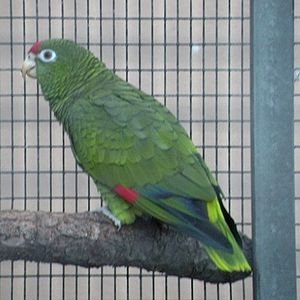Tucuman Amazon
| Tucuman Amazon | ||||||||||||
|---|---|---|---|---|---|---|---|---|---|---|---|---|

Tucuman Amazon ( Amazona tucumana ) |
||||||||||||
| Systematics | ||||||||||||
|
||||||||||||
| Scientific name | ||||||||||||
| Amazona tucumana | ||||||||||||
| ( Cabanis , 1885) |
The Tucumán Amazon ( Amazona tucumana ), also spelled Tucuman Amazon , is a species of parrot from the subfamily of the New World parrots .
description
The basic color of the plumage of this 31 centimeter Amazon species is green. All feathers of the body plumage have black borders. On the head, the forehead and the front parting are colored red. The upper and lower tail-covers of the wings stand out from the rest of the body plumage by a yellowish-green color. The swinging hand covers, on the other hand, are red. The beak is horn-colored, whereas the featherless eye ring is white.
Distribution and habitat
The distribution area of the Tucumán Amazon extends from a small area in the south of Bolivia to the north-west of Argentina . They live there mainly in the mountain forests of the Andes at altitudes between 1000 and 2200 meters. The Tucumán Amazons, who live in small groups or swarms, nomadize within their area of distribution. The hikes are determined by the food supply. In winter, the parrots migrate to lower altitudes and then stay at heights of around 300 meters. Large parts of the habitats of the Tucumán Amazons now belong to national parks, so that the species is not considered to be directly threatened. The population of this parrot species is only about 5,500 individuals.
Way of life
The preferred food of the Tucumán Amazons is alder or araucaria seeds . In addition, fruits, seeds, nuts and berries from other trees and bushes are eaten. Data on the reproduction mode of this parrot species are only available from captivity. Afterwards, Tucumán Amazons lay between one and four eggs. These are incubated for 27 to 28 days.
Duration
The trade in Tucumán Amazons has been banned since the early 1990s. The species is listed in Appendix I of the Washington Convention on the Protection of Species as an endangered species. The Zoo Karlsruhe has initiated in 1991 a captive breeding project of Tucuman Amazons were involved in the private holder. In the first year, eleven young birds were raised successfully as part of this project. At the height of the project, seventy keepers with around 250 Tucumán Amazons took part. The project was discontinued, however, after the free-range populations proved to be less threatened than originally assumed and data collection from private owners proved to be difficult.
swell
literature
- Susanne Lantermann and Werner Lantermann: The parrots of Central and South America , Verlag M. & H. Schaper, Hanover 1986, ISBN 3-7944-0149-2
- Werner Lantermann (2007): Amazon parrots - biology, endangerment, keeping, species , Filander publishing house, ISBN 978-3-930831-66-1
- John Stoodley, Pat Stoodley: Genus Amazona , Bezels Publications, Lovedean 1990, ISBN 0-947756-02-7
Individual evidence
- ↑ a b c Lantermann (2007), p. 114
- ^ Susanne and Werner Lantermann, 1986, p. 99
- ↑ Lantermann (2007), p. 115
Web links
- Videos, photos and sound recordings of Amazona tucumana in the Internet Bird Collection
- Amazona tucumana inthe IUCN 2013 Red List of Endangered Species . Listed by: BirdLife International, 2012. Retrieved September 15, 2013.